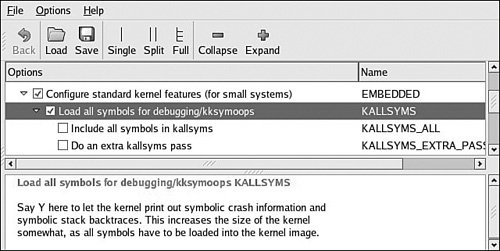Книга: Embedded Linux Primer: A Practical, Real-World Approach
13.4.8. Kernel Oops
13.4.8. Kernel Oops
Although not strictly a tool, a kernel oops contains much useful information to help you troubleshoot the cause. A kernel oops results from a variety of kernel errors from simple memory errors produced by a process (fully recoverable, in most cases) to a hard kernel panic. Recent Linux kernels support display of symbolic information in addition to the raw hexadecimal address values. Listing 13-14 reproduces a kernel oops from a PowerPC target.
Listing 13-14. Kernel Oops
$ modprobe loop
Oops: kernel access of bad area, sig: 11 [#1]
NIP: C000D058 LR: C0085650 SP: C7787E80 REGS: c7787dd0 TRAP: 0300 Not tainted
MSR: 00009032 EE: 1 PR: 0 FP: 0 ME: 1 IR/DR: 11
DAR: 00000000, DSISR: 22000000
TASK = c7d187b0[323] 'modprobe' THREAD: c7786000
Last syscall: 128
GPR00: 0000006C C7787E80 C7D187B0 00000000 C7CD25CC FFFFFFFF 00000000 80808081
GPR08: 00000001 C034AD80 C036D41C C034AD80 C0335AB0 1001E3C0 00000000 00000000
GPR16: 00000000 00000000 00000000 100170D8 100013E0 C9040000 C903DFD8 C9040000
GPR24: 00000000 C9040000 C9040000 00000940 C778A000 C7CD25C0 C7CD25C0 C7CD25CC
NIP [c000d058] strcpy+0x10/0x1c
LR [c0085650] register_disk+0xec/0xf0
Call trace:
[c00e170c] add_disk+0x58/0x74
[c90061e0] loop_init+0x1e0/0x430 [loop]
[c002fc90] sys_init_module+0x1f4/0x2e0
[c00040a0] ret_from_syscall+0x0/0x44
Segmentation fault
Notice that the register dump includes symbolic information, where appropriate. Your kernel must have KALLSYSMS enabled for this symbolic information to be available. Figure 13-4 shows the configuration options under the General Setup main menu.
Figure 13-4. Symbol support for oops

Much of the information in a kernel oops message is directly related to the processor. Having some knowledge of the underlying architecture is necessary to fully understand the oops message.
Analyzing the oops in Listing 13-14, we see right away that the oops was generated due to a "kernel access of bad area, sig: 11". We already know from previous examples in this chapter that signal 11 is a segmentation fault.
The first section is a summary showing the reason for the oops, a few important pointers, and the offending task. In Listing 13-14, NIP is the next instruction pointer, which is decoded later in the oops message. This points to the offending code that led to the oops. LR is a PowerPC register and usually indicates the return address for the currently executing subroutine. SP is the stack pointer. REGS indicates the kernel address for the data structure containing the register dump data, and TRAP indicates the type of exception that this oops message relates to. Referring to the PowerPC architecture reference manual referenced at the end of Chapter 7, "Bootloaders," we see that a TRAP 0300 is the PowerPC Data Storage Interrupt, which is triggered by a data memory access error.
On the third line of the oops message, we see additional PowerPC machine registers, such as MSR (machine state register) and a decode of some of its bits. On the next line, we see the DAR (data access register), which often contains the offending memory address. The DSISR register contents can be used in conjunction with the PowerPC architecture reference to discover much detail about the specific reason for the exception.
An oops message also contains the task pointer and the decoded task name to quickly determine what task or thread was running at the time of the oops. We also see a detailed processor register dump, which can be used for additional clues. Again, we need knowledge of the architecture and compiler register usage to make sense of the clues from the register values. For example, the PowerPC architecture uses the r3 register for return values from C functions.
The last part of the oops message provides a stack backtrace with symbol decode if symbols are enabled in the kernel. Using this information, we can construct a sequence of events that led to the offending condition.
In this simple example, we have learned a great deal of information from this oops message. We know that it was a PowerPC Data Storage Exception, caused by an error in a data memory access (as opposed to an instruction fetch memory access). The DAR register tells us that the data address that generated this exception was 0x0000_0000. We know that the modprobe process produced the error. From the backtrace and NIP (next instruction pointer), we know that it was in a call to strcpy() that can be traced directly back to the loop_init() function in the loop.ko module, which modprobe was trying to insert at the time of the exception. Given this information, tracking down the source of this errant null pointer dereference should be quite trivial.




